Modern Teaching Handbook
Master modern education with the all-in-one resource for educators. Get your free copy now!
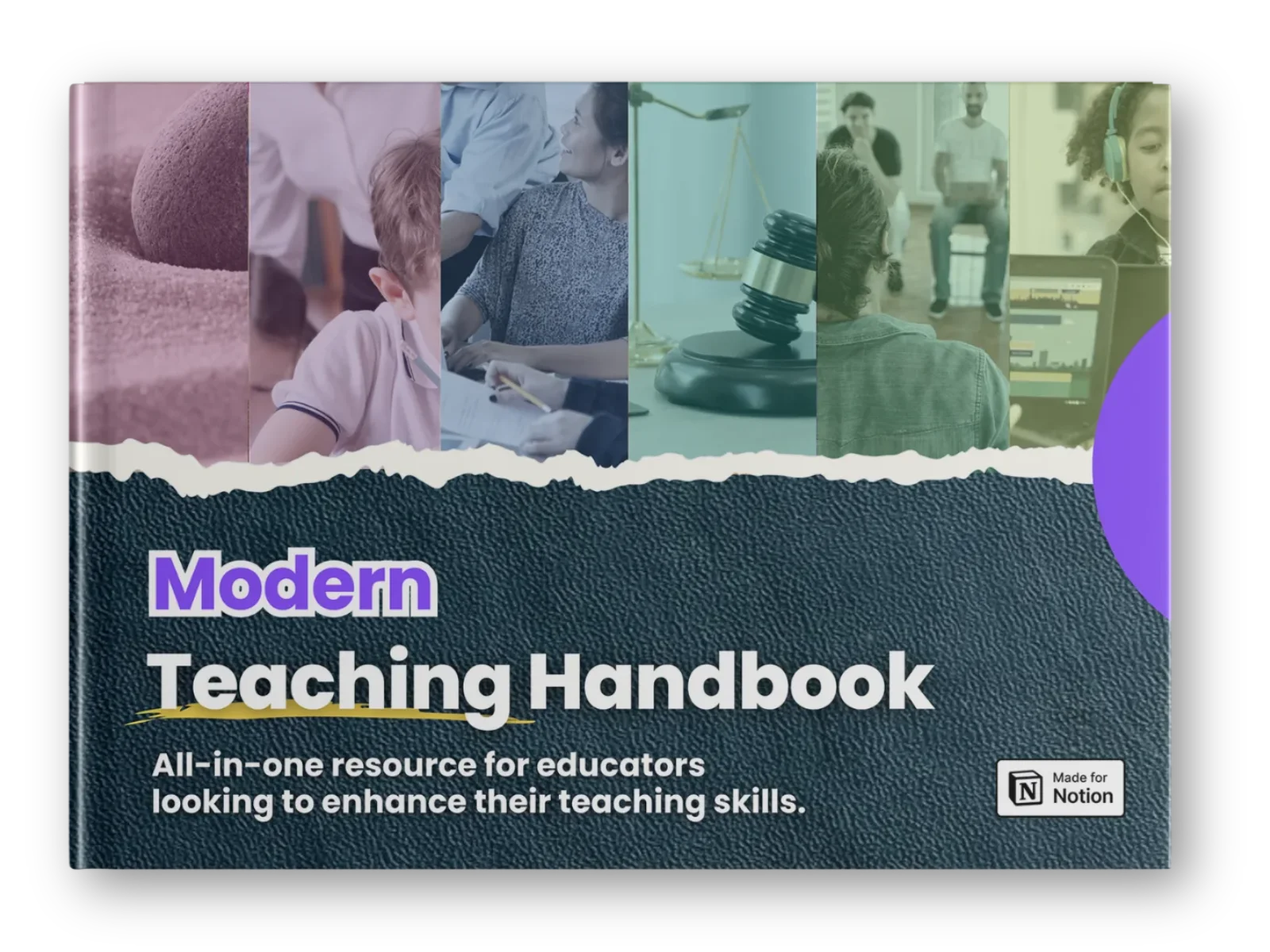


Environmental Impact on Learning: Teacher's Implementation Guide
Environmental Impact on Learning: Teacher's Implementation Guide
Environmental Impact on Learning: Teacher's Implementation Guide

Article by
Milo
ESL Content Coordinator & Educator
ESL Content Coordinator & Educator
All Posts
Imagine trying to study for an important exam in the middle of a chaotic, noisy café. The clinking of coffee cups, chattering patrons, and the occasional burst of laughter make it nearly impossible to focus. Now, compare that to sitting in a quiet, well-lit library. The contrast is staggering, right? This isn't just about preference; research shows that a student’s learning environment plays a huge role in their academic success.
Imagine trying to study for an important exam in the middle of a chaotic, noisy café. The clinking of coffee cups, chattering patrons, and the occasional burst of laughter make it nearly impossible to focus. Now, compare that to sitting in a quiet, well-lit library. The contrast is staggering, right? This isn't just about preference; research shows that a student’s learning environment plays a huge role in their academic success.
Modern Teaching Handbook
Master modern education with the all-in-one resource for educators. Get your free copy now!

Modern Teaching Handbook
Master modern education with the all-in-one resource for educators. Get your free copy now!

Modern Teaching Handbook
Master modern education with the all-in-one resource for educators. Get your free copy now!

The Role of the Learning Environment in Academic Success
Why the Learning Environment Matters
The space where students learn is more than just a room with desks and chairs. It’s a dynamic setting that can either boost their ability to focus and retain information or create distractions that act like hurdles in a track race. Studies in educational psychology have repeatedly emphasized that factors like lighting, noise levels, air quality, and even seating arrangements have a measurable impact on how students perform.
Think about it this way: a classroom is the stage where learning happens. If the stage is poorly designed, even the best actors (students and teachers) will struggle to perform at their peak. This is why it’s crucial to create spaces that set students up for success.
The Surprising Impact of Small Details
Sometimes, it’s the little things that can make a big difference. For instance:
Temperature: A classroom that’s too hot or too cold can make even the most motivated student fidgety and distracted. Ideal temperatures, studies suggest, fall between 68°F and 74°F. Somewhere between “sweaters are cozy” and “air-conditioning isn’t a life necessity.”
Seating Arrangements: A traditional row-based seating plan might work for lectures, but it stifles collaboration and group work. Compare this to clustered or circular setups, which encourage discussion and make students feel like part of a team.
Decluttered Space: A messy or overcrowded room can overstimulate students. A clean and organized classroom helps students feel calm and focused, which can make a world of difference during stressful lessons.
Can you relate to any of these? Maybe you’ve struggled to pay attention in a room where old bulletin board staples were falling out or loose wires created constant tripping hazards. These distractions might seem minor, but they can snowball into significantly lower engagement.
A Holistic Impact on Students
A well-designed learning environment doesn’t only help with test scores—it can affect students’ overall well-being. Think about the amount of time many students spend in classrooms. If those spaces feel rigid and unwelcoming, it could affect their sense of safety and comfort, which are fundamental to maintaining good mental health.
For example:
Bright, natural light doesn’t just reduce eye strain; it boosts mood by increasing serotonin levels. Who doesn’t appreciate a little sunshine while tackling math equations?
Reduced background noise helps students hear instructions clearly and ensures that soft-spoken classmates' voices don’t get lost in the ether.
When schools prioritize thoughtful design, they’re sending a clear message: "We care about your comfort and success." This kind of effort reinforces a positive attitude toward learning and can foster a sense of belonging among students.
Wrapping It Up
Creating the perfect learning environment isn’t about expensive renovations or high-tech gadgets. It’s about understanding how students interact with their surroundings and making small, intentional changes that improve their experience. From ergonomic chairs to better airflow, every choice matters.
Ready to dive deeper? Next, we’ll explore the stressors that often arise in classrooms—and how to tackle them head-on!

Understanding Environmental Stressors in the Classroom
Imagine a student sitting at their desk, trying to focus on a math quiz. Outside the window, a lawnmower roars to life, cutting through their concentration like a knife. Meanwhile, the harsh glare of fluorescent lights overhead makes their eyes strain, and the crowded layout of desks gives them little room to breathe. Sound familiar? These are just a few examples of environmental stressors that can turn the classroom into a challenging place for learning.
Environmental stressors are external factors—often overlooked—that influence a student’s ability to concentrate, process information, and thrive academically. Let’s break them down and explore their effects.
Common Environmental Stressors
Though seemingly minor, these factors can pack a serious punch when it comes to student performance:
Noise:
Noise is a top culprit in disrupting learning environments. This doesn’t just mean loud explosions or music (though those are obvious). Subtle, ongoing sounds like a humming air conditioner, hallway chatter, or footsteps from the floor above can quietly chip away at a student’s focus.
Example: A study found that students in classrooms near highways or airports often score lower on reading tests. Why? Consistent background noise interrupts cognitive function, making it harder to process and store information.
Lighting:
Lighting plays a sneaky but significant role in learning. Poor lighting (too dim or overly harsh) can lead to eye strain and fatigue, while inadequate natural light can affect mood and energy levels. Ever felt like your brain was sluggish on a grey, rainy day? Students feel this way in poorly lit classrooms, too.
On the flip side, classrooms that maximize natural light have been shown to increase productivity and boost morale.
Temperature:
Is it an arctic tundra in your classroom or a tropical rainforest? Extreme classroom temperatures can make a big difference. If the room feels too cold, students may feel distracted and uncomfortable. On the other hand, if it’s sweltering, sluggishness and irritation creep in.
Teachers may notice performance dips when students are too busy adjusting their sweaters or fanning themselves to fully engage in lessons.
The Domino Effect of Stressors
These stressors don’t operate in isolation; they’re like dominoes, knocking down focus, mood, and engagement one by one.
Cognitive Impact:
When kids are bombarded by constant noise or dim lighting, their brain has to work overtime to block out distractions. This “mental bandwidth drain” makes it harder to absorb material and can lead to burnout faster.Behavioral Shifts:
Ever had students get restless or cranky for no clear reason? It might not be hormones—it could be the environment. Stress impacts behavior, leading to fidgeting, disengagement, or even conflict among peers.Long-Term Outcomes:
If stressors aren’t addressed, the negative effects can snowball. Chronic discomfort and distraction can harm a child’s confidence in learning and even their long-term academic trajectory.
Identifying and Addressing Stressors
The first step to addressing environmental stressors is identifying them. Take a look around your space:
Is a nearby construction site making concentration impossible?
Are the lights leaving half the room in shadow?
Does the heating system feel like it has a mind of its own, alternating between freezing and boiling?
Sometimes, even small tweaks can make a big difference:
Add rugs or soft furnishings to absorb sound.
Use curtains to minimize glare, or experiment with moving desks closer to windows for natural light.
Keep a thermometer handy and adjust the thermostat (if possible), or encourage layered clothing for temperature shifts.
By proactively tackling these sneaky stressors, you create a calmer, more focused learning environment where everyone wins.
And once those distractions melt away, students can focus on what really matters—learning, growing, and acing that quiz on fractions! Ready to evaluate your classroom’s setup? Let’s dive in!

The Impact of Natural Light and Noise Levels on Student Focus
Here’s a question for you: Have you ever tried to read in a dimly lit room or focus on work while someone nearby mowed their lawn? Frustrating, right? Now imagine that same scenario for students trying to concentrate in school. Natural light and ambient noise levels may seem like small details, but they play a big role in student focus and academic performance.
Why Natural Light is the Ultimate Study Buddy
Let’s face it: nobody thrives in a cave. Natural light isn’t just nice to have—it’s essential for both physical and mental well-being. Studies have shown that classrooms with abundant natural light can significantly boost students' mood, energy levels, and even test scores. Why? It’s all thanks to our biological clock.
Circadian rhythm matters: Our bodies are wired to respond to natural light. It helps regulate sleep-wake cycles, making us feel more alert during the day.
Vitamin D boost: Sunlight triggers the production of Vitamin D, which is linked to improved mood and cognitive function. Translation? Sunlit classrooms = happier, sharper students.
Less eye strain: Artificial lighting can often cause glare or flickering, leading to headaches and tired eyes. Natural light reduces these distractions and makes reading or writing easier.
Take this example: A 2019 study comparing students in brightly lit classrooms with those in low-light environments found that students in well-lit spaces consistently performed better on tasks requiring sustained attention. Coincidence? Definitely not.
So, teachers and administrators, if you’re choosing between blinds or open windows, go with the sunlight. Your students will thank you—even if it’s just subconsciously.
The Problem with Classroom Noise (and How to Fix It)
Now let’s talk about noise. The hum of an air conditioner. The scrape of chairs. The booming laughter of students in the hallway. These sounds might not seem harmful, but they add up, creating the kind of background chaos that’s kryptonite to focus.
Here’s what noise can do:
Divided attention: Constant distractions force the brain to split focus, reducing comprehension and task efficiency.
Increased stress: Persistent noise can elevate cortisol levels, making students feel anxious and irritable.
Impaired auditory learning: Students who rely on listening—think lectures, discussions, or verbal instructions—struggle when competing sounds are too loud.
For example, think of Sarah, a mid-level student seated near a squeaky door that’s constantly opening and closing. Sure, she might not notice the sound at first, but over time, it chips away at her ability to stay engaged. Multiply this scenario by a full class, and you’ve got a recipe for disengagement.
Luckily, there are ways to combat noise pollution:
Add soft furnishings like carpets or curtains to absorb sound.
Use classroom sound machines or white noise to drown out distracting noise.
Position seating away from high-traffic areas, like near hallways or windows that face busy streets.
When Natural Light and Silence Work Together
Imagine this dream environment: Bright sunlight filters through large windows while the room hums with focused energy (and zero noisy distractions). In such an ideal setting, students are more likely to feel calm, stay motivated, and, most importantly, focus on the tasks at hand.
By prioritizing natural light and effectively managing noise levels, educators create a learning environment that supports everyone—from the easily distracted dreamer to the diligent overachiever. So, next time you’re setting up a classroom, remember: some of the smallest changes can spark the biggest improvements.
Now, let’s see how design choices like these tie into overall classroom layouts. Stay tuned!

How Classroom Layout Influences Engagement and Collaboration
Picture this: You walk into a classroom, and the desks are arranged in rigid, straight rows like soldiers standing at attention. The teacher's desk looms at the front like a stage where all the action happens. How does it feel? Probably not very inspiring. Now imagine a different room where desks are grouped into small clusters, or there's a big, shared table perfect for discussions. It feels more dynamic, right? That’s because the way a classroom is laid out has a huge impact on how students engage and work together.
Why Classroom Layout Matters
Classroom design isn’t just about aesthetics. It plays a functional role in shaping how students interact with each other, their teacher, and the learning material. A strategically designed layout doesn’t just make a space look nice—it can ignite curiosity and foster collaboration. Who knew the way desks are organized could make or break a group project?
Here’s the kicker: there isn’t a one-size-fits-all layout. What works depends on the activities planned and the needs of the students.
Different Layout Styles and Their Benefits
So, what are your options? Let’s break it down:
Traditional Rows
Pros:
Great for focused, individual work and standardized test-taking.
Reduces distractions since students are all facing forward.
Cons:
Limits interaction and collaboration—goodbye, group brainstorming sessions!
Can feel overly rigid, which dampens creative energy.
Grouped Desks or Clusters
Pros:
Encourages teamwork and discussion, perfect for collaborative learning.
Students are more likely to share ideas and solve problems together.
Cons:
Might get noisy (hello, chit-chat during quiet time!).
Can make it harder for teachers to keep an eye on everyone’s progress.
U-Shaped Layout
Pros:
Promotes engagement during class discussions or presentations.
Every student gets a front-row seat (no hiding in the back!).
Cons:
Eats up a lot of classroom space.
Not ideal for large classes.
Flexible Seating
Pros:
Provides options like bean bags, standing desks, or floor cushions—great for diverse learning styles.
Helps students feel more comfortable and empowered in their space.
Cons:
Requires constant adjustment and maintenance—it’s harder to control chaos when everyone wants to sit somewhere different.
Practical Tips for Teachers
Thinking of giving your classroom a layout makeover? Here are a few things to consider before getting out the measuring tape:
Know Your Goals: What’s the primary focus for your class? If it’s teamwork, lean toward clusters or a U-shape. For lectures or exams, rows might be your friend.
Flexibility Is Key: Think modular! Use lightweight furniture you can easily move around to fit different activities.
Ask for Input: Believe it or not, students often have strong opinions about how they like to learn. Get their thoughts before rearranging everything.
Swap things around and see what clicks with your class. Bonus tip: Keep pathways clear—nobody likes feeling trapped when they need to sharpen their pencil or grab a book.
Designing for Engagement Isn't a One-Time Fix
Here’s the thing: The perfect classroom layout is a moving target. As students grow more comfortable or as their needs evolve, what worked in September might need tweaking by March. Experimentation is your best friend in finding what strikes the right balance between engagement, collaboration, and focus.
So, next time you’re tempted to just stick with “easy” rows, grab a coffee, roll up your sleeves, and start rearranging. A few well-placed desks could just transform how your students learn—and, who knows, maybe even how they see themselves as learners.
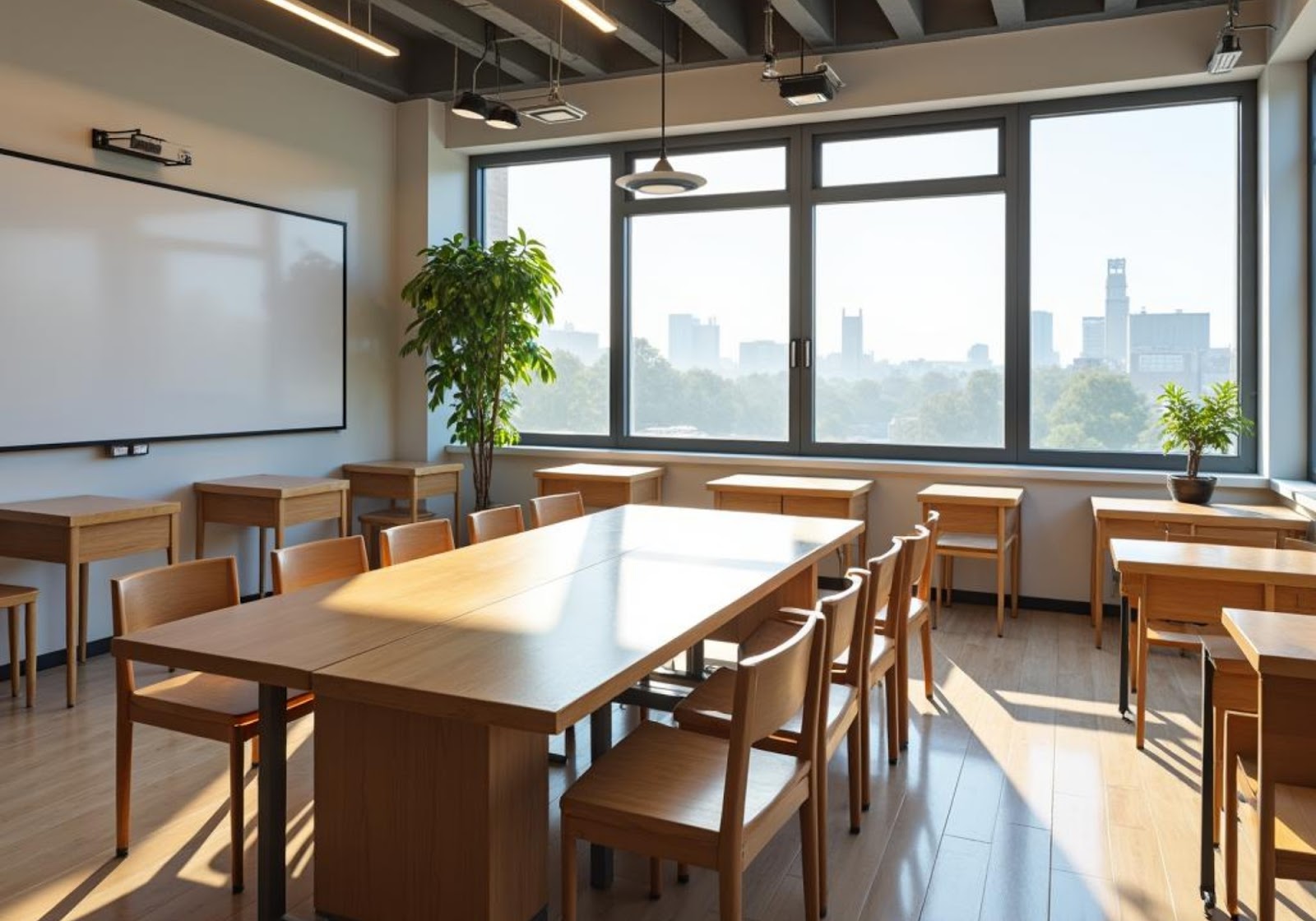
Integrating Green Practices to Enhance Cognitive Function
Ever felt that refreshing boost of clarity after stepping outside for some fresh air? That’s not just in your head—studies have shown that natural elements can boost brain function and creativity. What if we could bring that same magic into the classroom? Integrating green practices isn’t just a trendy sustainability move; it’s a way to create a smarter, healthier learning space for students. Let’s explore how adding a little “green” can lead to a lot of mental gain.
Why Green Matters for the Brain
Before diving into the how-tos, let’s take a minute to understand the why. Nature has a profound impact on our brains. Exposure to greenery has been linked to reduced stress, improved focus, and enhanced memory retention. According to research, students in classrooms enriched with natural elements, like plants and natural materials, often outperform their peers in sterile, plain spaces. Think of green classroom practices as brain fuel for young learners.
Simple Ways to Green Up Your Classroom
Now, you don’t need a rooftop garden or a giant budget to introduce eco-friendly practices into your classroom. Small, intentional changes can make a big difference. Here’s how:
Add Indoor Plants
Why it works: Plants naturally purify the air, creating a healthier breathing environment. Plus, their mere presence can reduce tension and improve focus.
What you can do: Start small with hardy, low-maintenance plants like spider plants, pothos, or succulents. Have students take turns caring for them—it’s a biology lesson, too!
Minimize Plastic Usage and Go Sustainable
Why it works: Ditching disposable plastic products cuts down on waste and reduces exposure to harmful toxins.
What you can do: Stock your classroom with bamboo utensils, refillable markers, or recycled stationery. Bonus points if your students make pencil holders out of old cans or jars during an art project!
Bring in Natural Light
Why it works: Harsh fluorescent lighting doesn’t do anyone any favors. Natural light, on the other hand, improves attention and supports healthy sleep cycles.
What you can do: If possible, rearrange your classroom to maximize sunlight exposure. Use light, airy curtains instead of thick ones. No big windows? Consider full-spectrum light bulbs as a solid substitute.
Think Bigger: Group Green Initiatives
Want to take things up a notch? Green practices can also serve as collaborative projects, turning learning into action:
Class Composting Program
Introduce a small compost bin where students can dump fruit peels or other organic waste from lunches. Use the composted material to feed outdoor plants or a school garden.Recycled DIY Projects
Collect used paper, cardboard, and other discarded materials for creative crafts. Imagine making bird feeders out of milk cartons or decorating the room using newspaper flowers.
Remember, these activities teach students how their actions can directly impact the planet—an invaluable life lesson.
The Domino Effect
Integrating green practices not only boosts cognitive function but creates a ripple effect of positivity. Students feel calmer, healthier, and more engaged in an eco-conscious environment. Beyond that, implementing these habits inspires kids to carry sustainability into their homes and communities. It's a win for the brain and the planet.
So, where will you start? Perhaps with a simple plant on your desk or a classroom closet cleanup? No matter how small the change, every step toward a greener classroom is a step toward smarter, happier students. After all, sometimes, growing minds just need a touch of green.
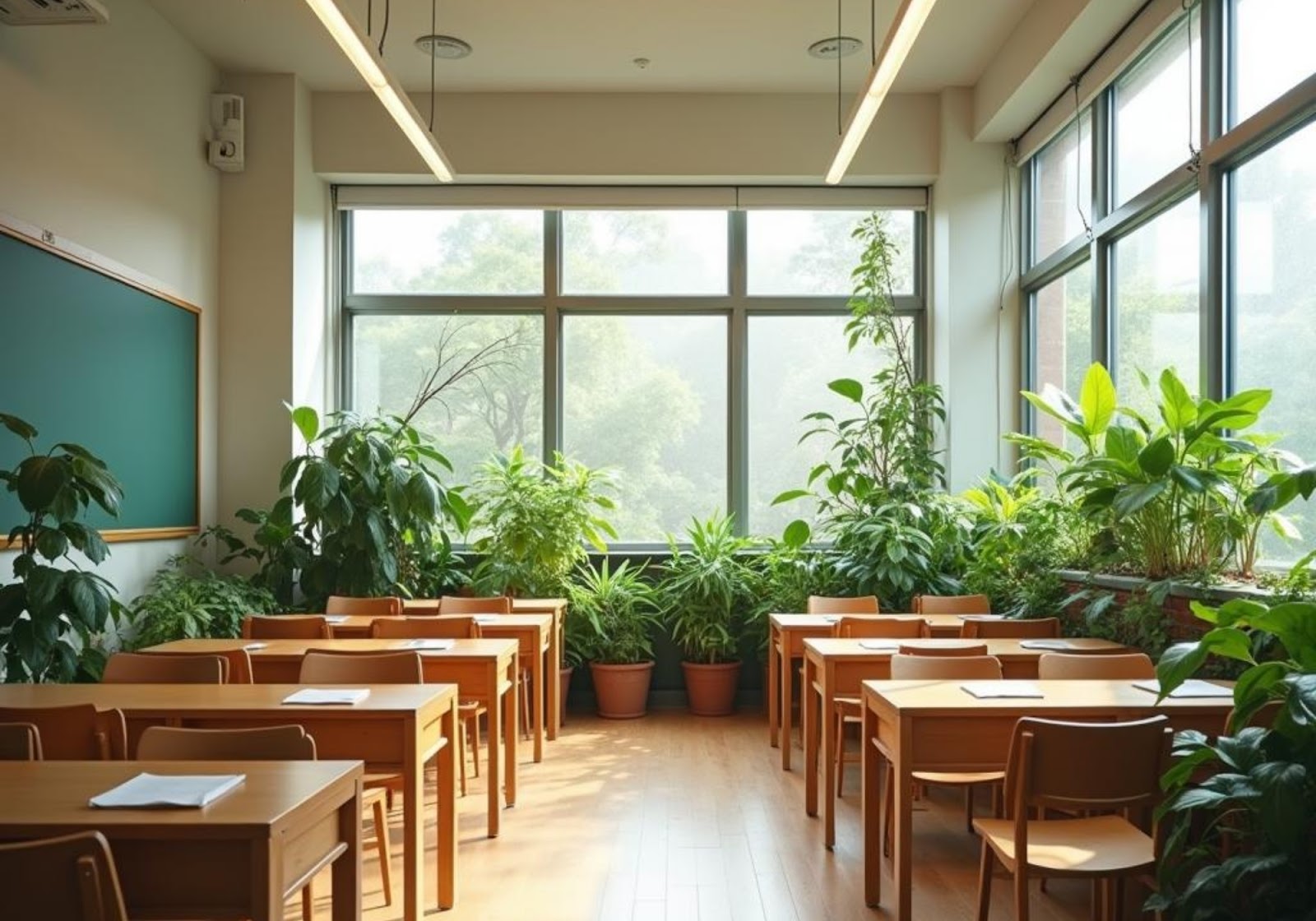
The Power of Color Psychology in Supporting Learning Retention
Did you know that the color blue can help you stay calm, while yellow might spark bursts of creativity? It’s true! Colors aren’t just for decorations—they can actively influence how we think, feel, and even retain information. That’s why understanding color psychology is so important when designing effective learning environments.
Whether you’re a teacher, parent, or student, choosing the right colors for a classroom can make a world of difference. Let’s dive into how the hues around us shape our learning experience!
The Science Behind Color and the Brain
Colors have a direct impact on our emotions and cognitive responses. When we see a color, it triggers certain signals in our brain, which influence our mood, focus, and memory retention. Think of it like tuning the vibe of a space. Here's a quick breakdown:
Warm colors (reds, oranges, yellows): These tend to evoke energy and excitement but can sometimes be overstimulating if overused.
Cool colors (blues, greens, purples): These are calming and help with focus, making them ideal for work and study settings.
Neutral colors (beige, white, gray): These serve as balancing backdrops but can become a bit bland or uninspiring if they dominate a space.
Using the right combination of colors can help create an environment that boosts memory retention and keeps students engaged without overwhelming their senses.
Ideal Colors for Different Learning Activities
Not every activity calls for high energy or intense focus. That’s why it’s important to consider what students will be doing most in the space. Let’s look at a few examples:
Focus-heavy tasks (like silent reading or test-taking):
Shades of blue are perfect for these activities because they’re calming and help students concentrate. Imagine a quiet nook in blue tones—perfect for reading comprehension practice!Collaborative group work:
Opt for green, which promotes balance and harmony. It’s soothing, but it also encourages thoughtful, cooperative conversations. Think brainstorming tables surrounded by gentle green walls.Creative activities (like art projects or writing):
This is where yellow shines. It stimulates imagination and optimism. However, don’t go overboard—splashes of yellow on a bulletin board or chair can do the trick without creating a chaotic feel.
Stressful moments (like before exams or public speaking):
Use muted tones (pale greens or soft grays) to reduce anxiety and create a sense of stability. For example, a calming corner with pastel colors can be a refuge when nerves run high.
Small Color Tweaks with Big Impacts
Don’t worry—you don’t have to repaint the entire classroom! Small changes can make a huge difference:
Bulletin Boards & Posters: Add pops of color to highlight important info or display student achievements.
Storage Spaces: Use colored bins or folders to organize materials. Bonus: it helps with visual association, so students remember where things are.
Desks and Seating: Cushions, chair covers, or even tape accents can add personality while serving psychological purposes.
A Classroom That's Easy on the Eyes—and the Brain
Here’s a handy tip to balance colors effectively: follow the 60-30-10 rule. Use 60% of a dominant neutral color (like white or beige), 30% of a secondary calming color (like blue or green), and 10% for accent colors (like yellow or red). This ensures that the environment feels balanced and welcoming, not chaotic.
For instance, a classroom could have off-white walls (60%), blue furniture (30%), and a few yellow library bins and posters (10%). It’s subtle yet stimulating!
Bottom Line: The Right Colors Make a Difference
Think of your classroom as a blank canvas—and colors as the tools that bring it to life. When chosen purposefully, colors can foster focus, spark creativity, and even help students absorb information better. So, next time you’re decorating or organizing your learning space, ask yourself: "What vibe am I creating?"
And hey, don’t hesitate to get the students involved! They might have great insights into what colors make them feel most productive or relaxed. After all, it’s their learning environment, too.
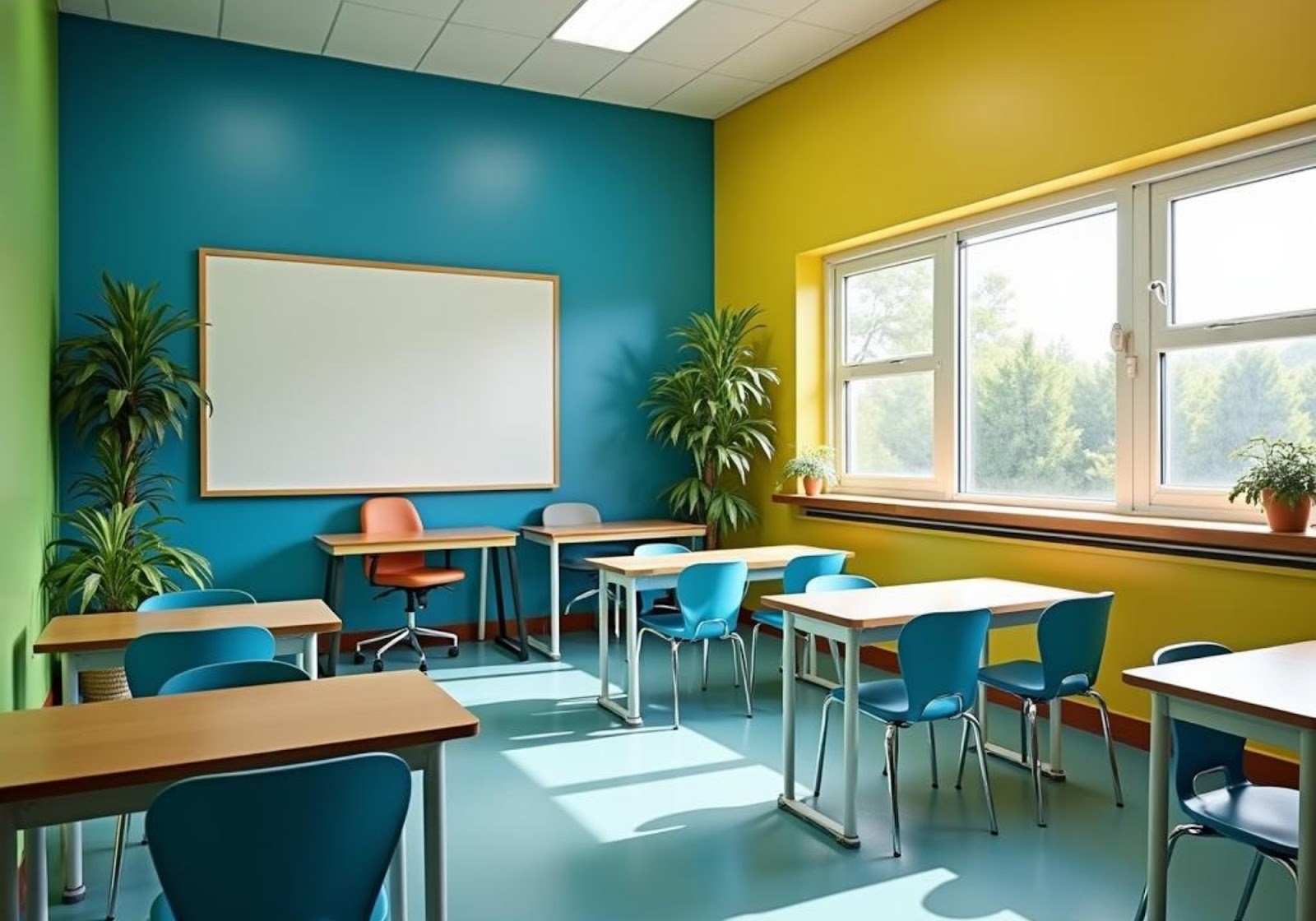
Strategies for Teachers to Create an Eco-Friendly Classroom Environment
Picture this: you walk into a classroom full of natural light, potted plants flourishing in the corners, and students sipping from colorful reusable water bottles instead of crinkling plastic ones. Sounds refreshing, right? Creating an eco-friendly classroom might seem challenging at first, but with a few thoughtful strategies, you can transform your teaching space into a greener, more sustainable haven for learning. Let’s dive into some practical and creative ways to make this happen.
Start with Small, Sustainable Steps
Going green doesn’t mean you have to overhaul everything overnight. Start small and build momentum. Even minor changes can make a huge difference.
Encourage Reusable Supplies: Suggest that students bring reusable water bottles, lunch containers, and even refillable pens. Over time, these small switches cut down on waste.
Create a Recycling Station: Equip your classroom with clearly labeled bins for paper, plastic, and other recyclables. Assigning student volunteers as “Recycling Captains” can make it fun and engaging.
Go Digital When Possible: Reduce paper waste by opting for digital assignments, newsletters, or handouts. Platforms like Google Classroom or Microsoft Teams make this seamless.
Tiny tweaks like these are easy to implement and set the tone for bigger changes.
Bring Nature Into the Classroom
Here’s a fun fact: exposure to greenery has been shown to improve focus and cognitive function. Why not let nature do some of the heavy lifting?
Add Plants: Pothos, spider plants, or succulents are low-maintenance options that improve air quality and brighten up the room. Get your students involved by letting them take turns watering or caring for the plants.
Use Natural Materials: Swap out plastic decorations for items made of wood, cork, or bamboo. These not only have a lower impact on the environment but also create a more calming, natural vibe.
Outdoor Lessons: Weather permitting, take learning outside. A lesson in the fresh air can recharge everyone’s energy while reinforcing your commitment to sustainability.
It’s amazing how much a bit of greenery can transform the mood of a classroom.
Minimize Energy Use
Making your classroom energy-efficient can inspire your students to be more mindful about their own habits at home.
Unplug Electronics: When devices aren’t in use, make unplugging them a habit. Even in standby mode, they consume power.
Switch to Energy-Efficient Lighting: If you can influence your school’s decisions, advocate for LED or energy-efficient lightbulbs in your classroom.
Utilize Natural Light: Whenever possible, open the blinds. Natural light is not only eco-friendly but also helps with focus and mood.
You can even turn energy-saving into a game with your students, setting goals to use fewer resources each month.
Educate Through Example
Finally, teaching eco-friendliness isn’t just about doing—it’s about showing. You can seamlessly weave sustainability into your lessons and classroom culture.
Incorporate Green Topics: Teach students about environmental issues, like climate change, pollution, or recycling practices.
Highlight Green Heroes: Share stories of individuals or organizations making strides in sustainability, from scientists to activists. This can be incredibly inspiring!
Reward Eco-Conscious Behavior: Create a “Green Star” system where students earn points for eco-friendly acts, like conserving paper or bringing waste-free lunches.
By modeling good habits yourself, such as using a reusable coffee mug or biking to school, you’re showing students that small actions can lead to big change.
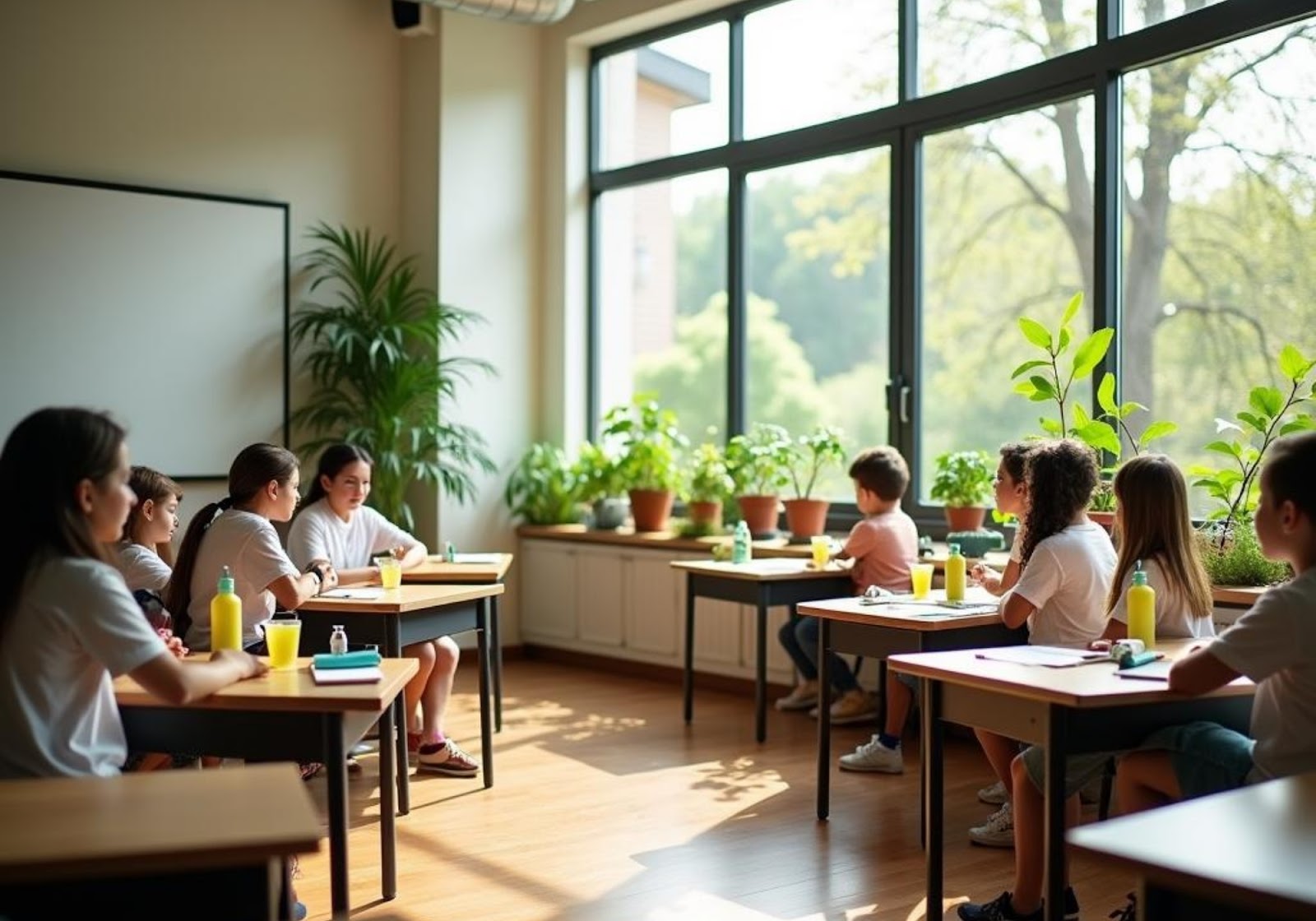
The Ripple Effect
Making your classroom eco-friendly isn’t just about your immediate space—it’s about fostering habits that ripple outward. Chances are, your students will carry these lessons home, sparking conversations and changes in their families.
Turn eco-friendliness into a team effort and celebrate the wins, no matter how small. Soon, your green classroom won’t just be a place of learning; it’ll be an example of sustainability in action! Now, grab a plant and some sunlight, and start that journey to greener learning today.
The Role of the Learning Environment in Academic Success
Why the Learning Environment Matters
The space where students learn is more than just a room with desks and chairs. It’s a dynamic setting that can either boost their ability to focus and retain information or create distractions that act like hurdles in a track race. Studies in educational psychology have repeatedly emphasized that factors like lighting, noise levels, air quality, and even seating arrangements have a measurable impact on how students perform.
Think about it this way: a classroom is the stage where learning happens. If the stage is poorly designed, even the best actors (students and teachers) will struggle to perform at their peak. This is why it’s crucial to create spaces that set students up for success.
The Surprising Impact of Small Details
Sometimes, it’s the little things that can make a big difference. For instance:
Temperature: A classroom that’s too hot or too cold can make even the most motivated student fidgety and distracted. Ideal temperatures, studies suggest, fall between 68°F and 74°F. Somewhere between “sweaters are cozy” and “air-conditioning isn’t a life necessity.”
Seating Arrangements: A traditional row-based seating plan might work for lectures, but it stifles collaboration and group work. Compare this to clustered or circular setups, which encourage discussion and make students feel like part of a team.
Decluttered Space: A messy or overcrowded room can overstimulate students. A clean and organized classroom helps students feel calm and focused, which can make a world of difference during stressful lessons.
Can you relate to any of these? Maybe you’ve struggled to pay attention in a room where old bulletin board staples were falling out or loose wires created constant tripping hazards. These distractions might seem minor, but they can snowball into significantly lower engagement.
A Holistic Impact on Students
A well-designed learning environment doesn’t only help with test scores—it can affect students’ overall well-being. Think about the amount of time many students spend in classrooms. If those spaces feel rigid and unwelcoming, it could affect their sense of safety and comfort, which are fundamental to maintaining good mental health.
For example:
Bright, natural light doesn’t just reduce eye strain; it boosts mood by increasing serotonin levels. Who doesn’t appreciate a little sunshine while tackling math equations?
Reduced background noise helps students hear instructions clearly and ensures that soft-spoken classmates' voices don’t get lost in the ether.
When schools prioritize thoughtful design, they’re sending a clear message: "We care about your comfort and success." This kind of effort reinforces a positive attitude toward learning and can foster a sense of belonging among students.
Wrapping It Up
Creating the perfect learning environment isn’t about expensive renovations or high-tech gadgets. It’s about understanding how students interact with their surroundings and making small, intentional changes that improve their experience. From ergonomic chairs to better airflow, every choice matters.
Ready to dive deeper? Next, we’ll explore the stressors that often arise in classrooms—and how to tackle them head-on!

Understanding Environmental Stressors in the Classroom
Imagine a student sitting at their desk, trying to focus on a math quiz. Outside the window, a lawnmower roars to life, cutting through their concentration like a knife. Meanwhile, the harsh glare of fluorescent lights overhead makes their eyes strain, and the crowded layout of desks gives them little room to breathe. Sound familiar? These are just a few examples of environmental stressors that can turn the classroom into a challenging place for learning.
Environmental stressors are external factors—often overlooked—that influence a student’s ability to concentrate, process information, and thrive academically. Let’s break them down and explore their effects.
Common Environmental Stressors
Though seemingly minor, these factors can pack a serious punch when it comes to student performance:
Noise:
Noise is a top culprit in disrupting learning environments. This doesn’t just mean loud explosions or music (though those are obvious). Subtle, ongoing sounds like a humming air conditioner, hallway chatter, or footsteps from the floor above can quietly chip away at a student’s focus.
Example: A study found that students in classrooms near highways or airports often score lower on reading tests. Why? Consistent background noise interrupts cognitive function, making it harder to process and store information.
Lighting:
Lighting plays a sneaky but significant role in learning. Poor lighting (too dim or overly harsh) can lead to eye strain and fatigue, while inadequate natural light can affect mood and energy levels. Ever felt like your brain was sluggish on a grey, rainy day? Students feel this way in poorly lit classrooms, too.
On the flip side, classrooms that maximize natural light have been shown to increase productivity and boost morale.
Temperature:
Is it an arctic tundra in your classroom or a tropical rainforest? Extreme classroom temperatures can make a big difference. If the room feels too cold, students may feel distracted and uncomfortable. On the other hand, if it’s sweltering, sluggishness and irritation creep in.
Teachers may notice performance dips when students are too busy adjusting their sweaters or fanning themselves to fully engage in lessons.
The Domino Effect of Stressors
These stressors don’t operate in isolation; they’re like dominoes, knocking down focus, mood, and engagement one by one.
Cognitive Impact:
When kids are bombarded by constant noise or dim lighting, their brain has to work overtime to block out distractions. This “mental bandwidth drain” makes it harder to absorb material and can lead to burnout faster.Behavioral Shifts:
Ever had students get restless or cranky for no clear reason? It might not be hormones—it could be the environment. Stress impacts behavior, leading to fidgeting, disengagement, or even conflict among peers.Long-Term Outcomes:
If stressors aren’t addressed, the negative effects can snowball. Chronic discomfort and distraction can harm a child’s confidence in learning and even their long-term academic trajectory.
Identifying and Addressing Stressors
The first step to addressing environmental stressors is identifying them. Take a look around your space:
Is a nearby construction site making concentration impossible?
Are the lights leaving half the room in shadow?
Does the heating system feel like it has a mind of its own, alternating between freezing and boiling?
Sometimes, even small tweaks can make a big difference:
Add rugs or soft furnishings to absorb sound.
Use curtains to minimize glare, or experiment with moving desks closer to windows for natural light.
Keep a thermometer handy and adjust the thermostat (if possible), or encourage layered clothing for temperature shifts.
By proactively tackling these sneaky stressors, you create a calmer, more focused learning environment where everyone wins.
And once those distractions melt away, students can focus on what really matters—learning, growing, and acing that quiz on fractions! Ready to evaluate your classroom’s setup? Let’s dive in!

The Impact of Natural Light and Noise Levels on Student Focus
Here’s a question for you: Have you ever tried to read in a dimly lit room or focus on work while someone nearby mowed their lawn? Frustrating, right? Now imagine that same scenario for students trying to concentrate in school. Natural light and ambient noise levels may seem like small details, but they play a big role in student focus and academic performance.
Why Natural Light is the Ultimate Study Buddy
Let’s face it: nobody thrives in a cave. Natural light isn’t just nice to have—it’s essential for both physical and mental well-being. Studies have shown that classrooms with abundant natural light can significantly boost students' mood, energy levels, and even test scores. Why? It’s all thanks to our biological clock.
Circadian rhythm matters: Our bodies are wired to respond to natural light. It helps regulate sleep-wake cycles, making us feel more alert during the day.
Vitamin D boost: Sunlight triggers the production of Vitamin D, which is linked to improved mood and cognitive function. Translation? Sunlit classrooms = happier, sharper students.
Less eye strain: Artificial lighting can often cause glare or flickering, leading to headaches and tired eyes. Natural light reduces these distractions and makes reading or writing easier.
Take this example: A 2019 study comparing students in brightly lit classrooms with those in low-light environments found that students in well-lit spaces consistently performed better on tasks requiring sustained attention. Coincidence? Definitely not.
So, teachers and administrators, if you’re choosing between blinds or open windows, go with the sunlight. Your students will thank you—even if it’s just subconsciously.
The Problem with Classroom Noise (and How to Fix It)
Now let’s talk about noise. The hum of an air conditioner. The scrape of chairs. The booming laughter of students in the hallway. These sounds might not seem harmful, but they add up, creating the kind of background chaos that’s kryptonite to focus.
Here’s what noise can do:
Divided attention: Constant distractions force the brain to split focus, reducing comprehension and task efficiency.
Increased stress: Persistent noise can elevate cortisol levels, making students feel anxious and irritable.
Impaired auditory learning: Students who rely on listening—think lectures, discussions, or verbal instructions—struggle when competing sounds are too loud.
For example, think of Sarah, a mid-level student seated near a squeaky door that’s constantly opening and closing. Sure, she might not notice the sound at first, but over time, it chips away at her ability to stay engaged. Multiply this scenario by a full class, and you’ve got a recipe for disengagement.
Luckily, there are ways to combat noise pollution:
Add soft furnishings like carpets or curtains to absorb sound.
Use classroom sound machines or white noise to drown out distracting noise.
Position seating away from high-traffic areas, like near hallways or windows that face busy streets.
When Natural Light and Silence Work Together
Imagine this dream environment: Bright sunlight filters through large windows while the room hums with focused energy (and zero noisy distractions). In such an ideal setting, students are more likely to feel calm, stay motivated, and, most importantly, focus on the tasks at hand.
By prioritizing natural light and effectively managing noise levels, educators create a learning environment that supports everyone—from the easily distracted dreamer to the diligent overachiever. So, next time you’re setting up a classroom, remember: some of the smallest changes can spark the biggest improvements.
Now, let’s see how design choices like these tie into overall classroom layouts. Stay tuned!

How Classroom Layout Influences Engagement and Collaboration
Picture this: You walk into a classroom, and the desks are arranged in rigid, straight rows like soldiers standing at attention. The teacher's desk looms at the front like a stage where all the action happens. How does it feel? Probably not very inspiring. Now imagine a different room where desks are grouped into small clusters, or there's a big, shared table perfect for discussions. It feels more dynamic, right? That’s because the way a classroom is laid out has a huge impact on how students engage and work together.
Why Classroom Layout Matters
Classroom design isn’t just about aesthetics. It plays a functional role in shaping how students interact with each other, their teacher, and the learning material. A strategically designed layout doesn’t just make a space look nice—it can ignite curiosity and foster collaboration. Who knew the way desks are organized could make or break a group project?
Here’s the kicker: there isn’t a one-size-fits-all layout. What works depends on the activities planned and the needs of the students.
Different Layout Styles and Their Benefits
So, what are your options? Let’s break it down:
Traditional Rows
Pros:
Great for focused, individual work and standardized test-taking.
Reduces distractions since students are all facing forward.
Cons:
Limits interaction and collaboration—goodbye, group brainstorming sessions!
Can feel overly rigid, which dampens creative energy.
Grouped Desks or Clusters
Pros:
Encourages teamwork and discussion, perfect for collaborative learning.
Students are more likely to share ideas and solve problems together.
Cons:
Might get noisy (hello, chit-chat during quiet time!).
Can make it harder for teachers to keep an eye on everyone’s progress.
U-Shaped Layout
Pros:
Promotes engagement during class discussions or presentations.
Every student gets a front-row seat (no hiding in the back!).
Cons:
Eats up a lot of classroom space.
Not ideal for large classes.
Flexible Seating
Pros:
Provides options like bean bags, standing desks, or floor cushions—great for diverse learning styles.
Helps students feel more comfortable and empowered in their space.
Cons:
Requires constant adjustment and maintenance—it’s harder to control chaos when everyone wants to sit somewhere different.
Practical Tips for Teachers
Thinking of giving your classroom a layout makeover? Here are a few things to consider before getting out the measuring tape:
Know Your Goals: What’s the primary focus for your class? If it’s teamwork, lean toward clusters or a U-shape. For lectures or exams, rows might be your friend.
Flexibility Is Key: Think modular! Use lightweight furniture you can easily move around to fit different activities.
Ask for Input: Believe it or not, students often have strong opinions about how they like to learn. Get their thoughts before rearranging everything.
Swap things around and see what clicks with your class. Bonus tip: Keep pathways clear—nobody likes feeling trapped when they need to sharpen their pencil or grab a book.
Designing for Engagement Isn't a One-Time Fix
Here’s the thing: The perfect classroom layout is a moving target. As students grow more comfortable or as their needs evolve, what worked in September might need tweaking by March. Experimentation is your best friend in finding what strikes the right balance between engagement, collaboration, and focus.
So, next time you’re tempted to just stick with “easy” rows, grab a coffee, roll up your sleeves, and start rearranging. A few well-placed desks could just transform how your students learn—and, who knows, maybe even how they see themselves as learners.

Integrating Green Practices to Enhance Cognitive Function
Ever felt that refreshing boost of clarity after stepping outside for some fresh air? That’s not just in your head—studies have shown that natural elements can boost brain function and creativity. What if we could bring that same magic into the classroom? Integrating green practices isn’t just a trendy sustainability move; it’s a way to create a smarter, healthier learning space for students. Let’s explore how adding a little “green” can lead to a lot of mental gain.
Why Green Matters for the Brain
Before diving into the how-tos, let’s take a minute to understand the why. Nature has a profound impact on our brains. Exposure to greenery has been linked to reduced stress, improved focus, and enhanced memory retention. According to research, students in classrooms enriched with natural elements, like plants and natural materials, often outperform their peers in sterile, plain spaces. Think of green classroom practices as brain fuel for young learners.
Simple Ways to Green Up Your Classroom
Now, you don’t need a rooftop garden or a giant budget to introduce eco-friendly practices into your classroom. Small, intentional changes can make a big difference. Here’s how:
Add Indoor Plants
Why it works: Plants naturally purify the air, creating a healthier breathing environment. Plus, their mere presence can reduce tension and improve focus.
What you can do: Start small with hardy, low-maintenance plants like spider plants, pothos, or succulents. Have students take turns caring for them—it’s a biology lesson, too!
Minimize Plastic Usage and Go Sustainable
Why it works: Ditching disposable plastic products cuts down on waste and reduces exposure to harmful toxins.
What you can do: Stock your classroom with bamboo utensils, refillable markers, or recycled stationery. Bonus points if your students make pencil holders out of old cans or jars during an art project!
Bring in Natural Light
Why it works: Harsh fluorescent lighting doesn’t do anyone any favors. Natural light, on the other hand, improves attention and supports healthy sleep cycles.
What you can do: If possible, rearrange your classroom to maximize sunlight exposure. Use light, airy curtains instead of thick ones. No big windows? Consider full-spectrum light bulbs as a solid substitute.
Think Bigger: Group Green Initiatives
Want to take things up a notch? Green practices can also serve as collaborative projects, turning learning into action:
Class Composting Program
Introduce a small compost bin where students can dump fruit peels or other organic waste from lunches. Use the composted material to feed outdoor plants or a school garden.Recycled DIY Projects
Collect used paper, cardboard, and other discarded materials for creative crafts. Imagine making bird feeders out of milk cartons or decorating the room using newspaper flowers.
Remember, these activities teach students how their actions can directly impact the planet—an invaluable life lesson.
The Domino Effect
Integrating green practices not only boosts cognitive function but creates a ripple effect of positivity. Students feel calmer, healthier, and more engaged in an eco-conscious environment. Beyond that, implementing these habits inspires kids to carry sustainability into their homes and communities. It's a win for the brain and the planet.
So, where will you start? Perhaps with a simple plant on your desk or a classroom closet cleanup? No matter how small the change, every step toward a greener classroom is a step toward smarter, happier students. After all, sometimes, growing minds just need a touch of green.

The Power of Color Psychology in Supporting Learning Retention
Did you know that the color blue can help you stay calm, while yellow might spark bursts of creativity? It’s true! Colors aren’t just for decorations—they can actively influence how we think, feel, and even retain information. That’s why understanding color psychology is so important when designing effective learning environments.
Whether you’re a teacher, parent, or student, choosing the right colors for a classroom can make a world of difference. Let’s dive into how the hues around us shape our learning experience!
The Science Behind Color and the Brain
Colors have a direct impact on our emotions and cognitive responses. When we see a color, it triggers certain signals in our brain, which influence our mood, focus, and memory retention. Think of it like tuning the vibe of a space. Here's a quick breakdown:
Warm colors (reds, oranges, yellows): These tend to evoke energy and excitement but can sometimes be overstimulating if overused.
Cool colors (blues, greens, purples): These are calming and help with focus, making them ideal for work and study settings.
Neutral colors (beige, white, gray): These serve as balancing backdrops but can become a bit bland or uninspiring if they dominate a space.
Using the right combination of colors can help create an environment that boosts memory retention and keeps students engaged without overwhelming their senses.
Ideal Colors for Different Learning Activities
Not every activity calls for high energy or intense focus. That’s why it’s important to consider what students will be doing most in the space. Let’s look at a few examples:
Focus-heavy tasks (like silent reading or test-taking):
Shades of blue are perfect for these activities because they’re calming and help students concentrate. Imagine a quiet nook in blue tones—perfect for reading comprehension practice!Collaborative group work:
Opt for green, which promotes balance and harmony. It’s soothing, but it also encourages thoughtful, cooperative conversations. Think brainstorming tables surrounded by gentle green walls.Creative activities (like art projects or writing):
This is where yellow shines. It stimulates imagination and optimism. However, don’t go overboard—splashes of yellow on a bulletin board or chair can do the trick without creating a chaotic feel.
Stressful moments (like before exams or public speaking):
Use muted tones (pale greens or soft grays) to reduce anxiety and create a sense of stability. For example, a calming corner with pastel colors can be a refuge when nerves run high.
Small Color Tweaks with Big Impacts
Don’t worry—you don’t have to repaint the entire classroom! Small changes can make a huge difference:
Bulletin Boards & Posters: Add pops of color to highlight important info or display student achievements.
Storage Spaces: Use colored bins or folders to organize materials. Bonus: it helps with visual association, so students remember where things are.
Desks and Seating: Cushions, chair covers, or even tape accents can add personality while serving psychological purposes.
A Classroom That's Easy on the Eyes—and the Brain
Here’s a handy tip to balance colors effectively: follow the 60-30-10 rule. Use 60% of a dominant neutral color (like white or beige), 30% of a secondary calming color (like blue or green), and 10% for accent colors (like yellow or red). This ensures that the environment feels balanced and welcoming, not chaotic.
For instance, a classroom could have off-white walls (60%), blue furniture (30%), and a few yellow library bins and posters (10%). It’s subtle yet stimulating!
Bottom Line: The Right Colors Make a Difference
Think of your classroom as a blank canvas—and colors as the tools that bring it to life. When chosen purposefully, colors can foster focus, spark creativity, and even help students absorb information better. So, next time you’re decorating or organizing your learning space, ask yourself: "What vibe am I creating?"
And hey, don’t hesitate to get the students involved! They might have great insights into what colors make them feel most productive or relaxed. After all, it’s their learning environment, too.

Strategies for Teachers to Create an Eco-Friendly Classroom Environment
Picture this: you walk into a classroom full of natural light, potted plants flourishing in the corners, and students sipping from colorful reusable water bottles instead of crinkling plastic ones. Sounds refreshing, right? Creating an eco-friendly classroom might seem challenging at first, but with a few thoughtful strategies, you can transform your teaching space into a greener, more sustainable haven for learning. Let’s dive into some practical and creative ways to make this happen.
Start with Small, Sustainable Steps
Going green doesn’t mean you have to overhaul everything overnight. Start small and build momentum. Even minor changes can make a huge difference.
Encourage Reusable Supplies: Suggest that students bring reusable water bottles, lunch containers, and even refillable pens. Over time, these small switches cut down on waste.
Create a Recycling Station: Equip your classroom with clearly labeled bins for paper, plastic, and other recyclables. Assigning student volunteers as “Recycling Captains” can make it fun and engaging.
Go Digital When Possible: Reduce paper waste by opting for digital assignments, newsletters, or handouts. Platforms like Google Classroom or Microsoft Teams make this seamless.
Tiny tweaks like these are easy to implement and set the tone for bigger changes.
Bring Nature Into the Classroom
Here’s a fun fact: exposure to greenery has been shown to improve focus and cognitive function. Why not let nature do some of the heavy lifting?
Add Plants: Pothos, spider plants, or succulents are low-maintenance options that improve air quality and brighten up the room. Get your students involved by letting them take turns watering or caring for the plants.
Use Natural Materials: Swap out plastic decorations for items made of wood, cork, or bamboo. These not only have a lower impact on the environment but also create a more calming, natural vibe.
Outdoor Lessons: Weather permitting, take learning outside. A lesson in the fresh air can recharge everyone’s energy while reinforcing your commitment to sustainability.
It’s amazing how much a bit of greenery can transform the mood of a classroom.
Minimize Energy Use
Making your classroom energy-efficient can inspire your students to be more mindful about their own habits at home.
Unplug Electronics: When devices aren’t in use, make unplugging them a habit. Even in standby mode, they consume power.
Switch to Energy-Efficient Lighting: If you can influence your school’s decisions, advocate for LED or energy-efficient lightbulbs in your classroom.
Utilize Natural Light: Whenever possible, open the blinds. Natural light is not only eco-friendly but also helps with focus and mood.
You can even turn energy-saving into a game with your students, setting goals to use fewer resources each month.
Educate Through Example
Finally, teaching eco-friendliness isn’t just about doing—it’s about showing. You can seamlessly weave sustainability into your lessons and classroom culture.
Incorporate Green Topics: Teach students about environmental issues, like climate change, pollution, or recycling practices.
Highlight Green Heroes: Share stories of individuals or organizations making strides in sustainability, from scientists to activists. This can be incredibly inspiring!
Reward Eco-Conscious Behavior: Create a “Green Star” system where students earn points for eco-friendly acts, like conserving paper or bringing waste-free lunches.
By modeling good habits yourself, such as using a reusable coffee mug or biking to school, you’re showing students that small actions can lead to big change.

The Ripple Effect
Making your classroom eco-friendly isn’t just about your immediate space—it’s about fostering habits that ripple outward. Chances are, your students will carry these lessons home, sparking conversations and changes in their families.
Turn eco-friendliness into a team effort and celebrate the wins, no matter how small. Soon, your green classroom won’t just be a place of learning; it’ll be an example of sustainability in action! Now, grab a plant and some sunlight, and start that journey to greener learning today.
Modern Teaching Handbook
Master modern education with the all-in-one resource for educators. Get your free copy now!

Modern Teaching Handbook
Master modern education with the all-in-one resource for educators. Get your free copy now!

Modern Teaching Handbook
Master modern education with the all-in-one resource for educators. Get your free copy now!

Table of Contents
Modern Teaching Handbook
Master modern education with the all-in-one resource for educators. Get your free copy now!
2024 Notion4Teachers. All Rights Reserved.
2024 Notion4Teachers. All Rights Reserved.
2024 Notion4Teachers. All Rights Reserved.
2024 Notion4Teachers. All Rights Reserved.







